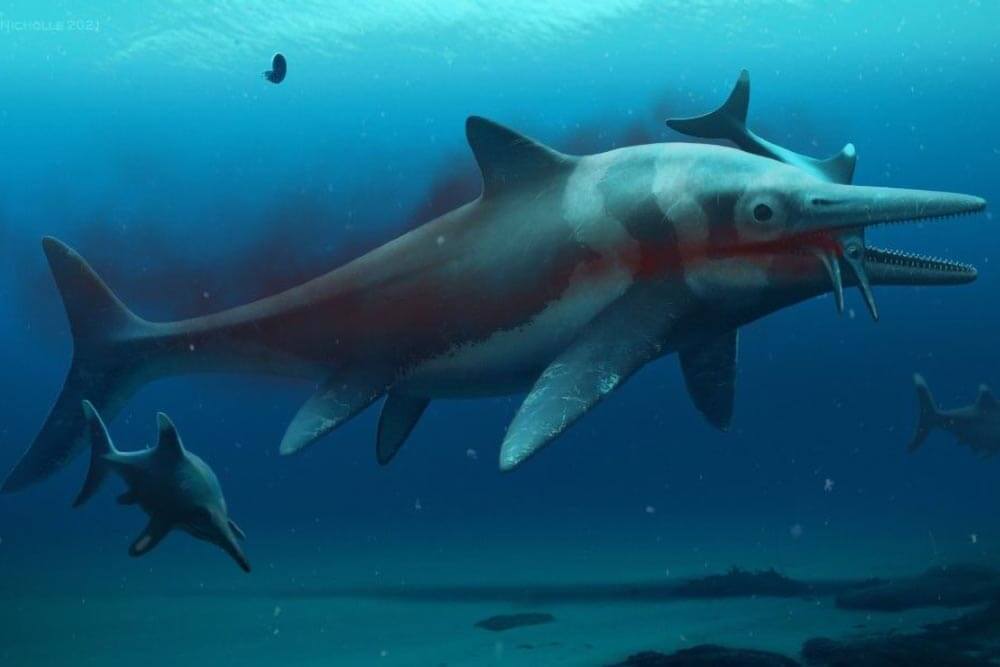
By DIVE Staff
The largest and most complete ichthyosaur fossil to be discovered in Britain has been excavated from the Rutland Water Nature Reserve.
The ichthyosaur, thought to be the first of the species Temnodontosaurus trigonodon to be found in the UK, was discovered by Joe Davis, Conservation Team Leader at Leicestershire and Rutland Wildlife Trust during a routine draining of the reserve in Feburary 2021.
‘The find has been absolutely fascinating and a real career highlight,’ said Davis. ‘It’s great to learn so much from the discovery and to think that this amazing creature was once swimming in seas above us, and now once again Rutland Water is a haven for wetland wildlife, albeit on a smaller scale!’
Ichthyosaurs first appeared in the fossil record around 250 million years ago and became extinct around 90 million years ago. They varied in size from 1 to 25m in length, and are often pictured as resembling dolphins – although it is not possible for the species to be related. The Rutland ichthyosaur has been dated at around 180 million years old, with a skeleton measuring some 10 metres in length and a skull weighing approximately one tonne.
The fossil was excavated in August and September of 2021 by a team of volunteers led by world ichthyosaur expert Dr Dean Lomax and specialist palaeontological conservator Nigel Larkin, together with marine reptile specialist Dr Mark Evans, and Dr Emma Nicholls from the Horniman Museum. The excavation was filmed for the BBC Two documentary series Digging Up Britain, to be broadcast on 11 January 2022.

‘It was an honour to lead the excavation,’ said Dr Lomax, who has named five new species during his career ‘Britain is the birthplace of ichthyosaurs – their fossils have been unearthed here for over 200 years, with the first scientific dating back to Mary Anning and her discoveries along the Jurassic Coast. Despite the many ichthyosaur fossils found in Britain, it is remarkable to think that the Rutland ichthyosaur is the largest skeleton ever found in the UK. It is a truly unprecedented discovery and one of the greatest finds in British palaeontological history.’
Dr Mark Evans of the British Antarctic Survey and a Visiting Fellow at the University of Leicester said: ‘I’ve been studying the Jurassic fossil reptiles of Rutland and Leicestershire for over twenty years. When I first saw the initial exposure of the specimen with Joe Davis I could tell that it was the largest ichthyosaur known from either county. However, it was only after our exploratory dig that we realised that it was practically complete to the tip of the tail. Rutland’s motto, “Multum in Parvo”, translates as “Much in Little” so it is fitting that we’ve found Britain’s largest ichthyosaur skeleton in England’s smallest county. It’s a highly significant discovery both nationally and internationally but also of huge importance to the people of Rutland and the surrounding area.’
‘Rutland Water has a long list of previous, fascinating archaeological and palaeontological discoveries, but none more exciting than this,’ said Peter Simpson, CEO for Anglian Water, the utility company which supplies water to the East of England and which maintains Rutland Nature Reserve. ‘As a water company, we have a role to bring environmental and social prosperity to our region, which is why the correct preservation and conservation of something so scientifically valuable and part of our history, is as important to us as ensuring our pipes and pumps are fit and resilient for the future. We also recognise the significance a find like this will have for the local community in Rutland. Our focus now is to secure the right funding to guarantee it’s legacy will last into the future.’
For more information visit: www.anglianwater.co.uk/rutlandseadragon. The ichthyosaur’s excavation will feature on BBC Two’s Digging for Britain on Tuesday 11th January at 8pm, and will be later be made available on the BBC iPlayer.


